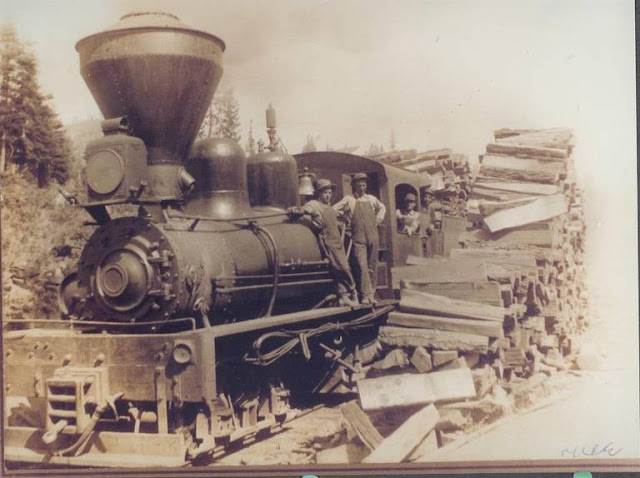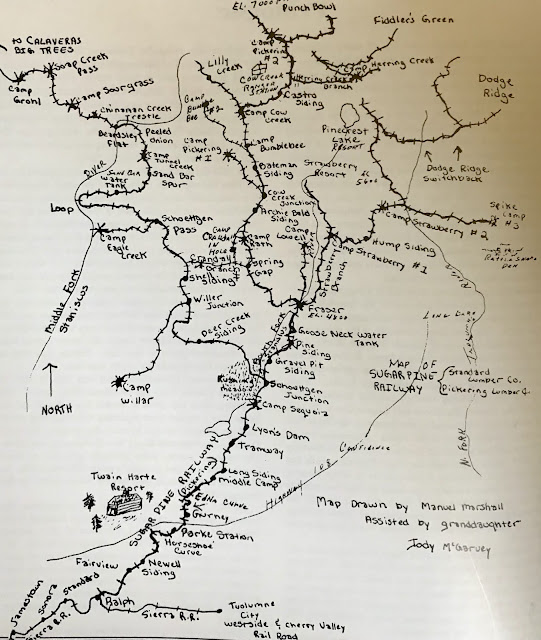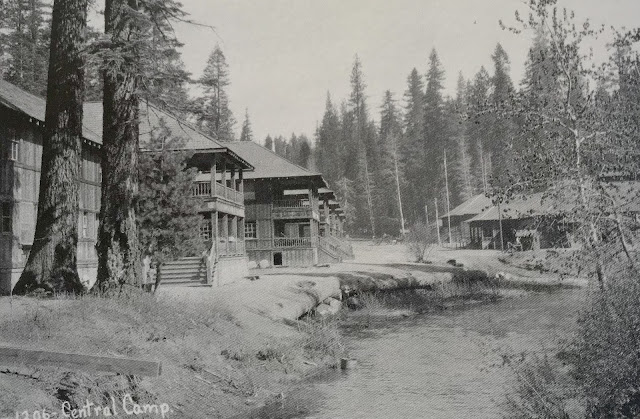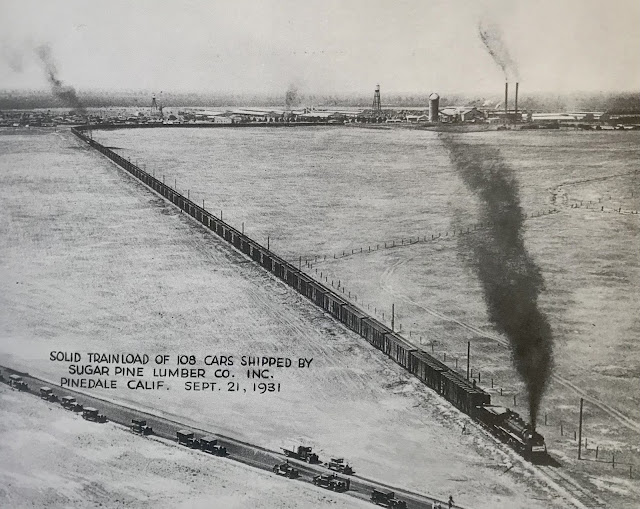The three following railroads are the main focus of my layout research.
MADERA-SUGARPINE CO. (1899-1932)
SUGARPINE RAILWAY & PICKERING/STANDARD LUMBER CO. (1903-1941)
SUGARPINE LUMBER CO. (1921-1931)
I chose these logging railroads as research for my N Scale layout. I plan to model it on a 4ft. X 6ft. size tabletop area. This layout will not be modeled after one specific logging railroad, but a combination of the three I have picked. Much of my research will be taken from books that I’ve acquired from various authors that have done extensive research on each of these operations. These logging operations are close to my home near Modesto, California and visiting the actual sites for exploring was a big considerations in choosing them to model.
(1) The Madera Sugar Pine Railroad Co. 1899-1932

The Madera-SugarPine Railroad Company existed from 1899 to 1932. This logging operation operated in the mountain area of Fish Camp north of Oakhurst and Bass Lake. It was close proximity to Yosemite NP and just south of Wawona and the park boundary. The processed lumber from the SugarPine sawmill operation was sent to Madera via a 54 mile flume system. The Madera Flume & Trading Company operated from 1878 to 1898 and succeeded to defunct California Lumber Co. which built a 52 mile V-flume (the longest in the world at the time). A two-saw steam mill was built on California Creek (eight miles northeast of Oakhurst) and seven miles of flume was erected originally.
The great Madera Flume near Lady Bug grade
Map of Madera Flume by Don DeVere
The MF&TC built two new mills in the Sierra, installed a Dolbeer steam donkey and two-pole log chutes in the woods. In 1889, the timber in close proximity to its mills was becoming cut over and the first logging railroad in the Sierra was built using a seven-ton, cog-geared locomotive known as “Betsy” and a dozen bob-tail log bunks.
“Old Betsy” circa 1901
“Old BETSY” of Sugar Pine
“Betsy” was purchased in 1899 from Madera Flume and Trading Co., its origination was unknown. This little steam engine was the first logging locomotive in the southern Sierra.
This sawmill was constructed six miles northwest of the former MF&T property and the original flume was extended to the new mill. The existing flume was re-built the entire 54 mile length. During the entire 31 years of operation, almost a billion-and-a-half board feet of lumber was shipped to the world-wide market. Innovations in high-lead and sky-line logging techniques enabled crews to reach remote stands of timber. The company used five wood-burning Shay engines and at its peak, employed over 800 men. The company voluntarily went out-of-business in 1933, a casualty of the Great Depression.
Map of the Madera-SugarPine by Don DeVere
Thunder in the Mountains
By Hank Johnston
The book written by Hank Johnston and illustrated by Don DeVere in 1968 and published by Trans-Angelo Books of Los Angeles, CA.. This publication chronicles the Life and Times of the Madera Sugar Pine Railroad. The Library of Congress Card No. is 68-23072.
This is a unique story about the first logging railroad in the southern Sierra and the flume conveyance that was utilised.
The Yosemite Mountain - Sugar Pine Excursion Railroad

The Yosemite Mt. SugarPine Railroad is an excursion railroad near Fishcamp just outside the Yosemite Nat’l. Park boundary. Today, this business provides excursion rides to the public on a portion of the track that existed during the Madera-Sugar Pine Railroad Company operation. Besides rides, they also host a rustic bbq and evening entertainment in the woods. This business started operation in September, 1967 with a Shay No. 10 purchased from the Westside Lumber Co. of Tuolumne County. Rudy Stauffer began the railroad using the old right-of-ways from the Madera-SugarPine RR.
YM&SP Railroad
By Hank Johnston & Rudy Stauffer
The book written by Hank Johnston, Rudy Stauffer and illustrated by Don DeVere in 1974 with modern photographs by Joseph Bisho. This publication chronicles a short history of the area lumbering of the Central Sierra. This pamphlet was produced for the Yosemite Mountain Sugar Pine Railroad, “A Stem-Powered Narrow-Gauge Journey into Sierra Logging History”
Illustration by Don DeVere (1974)
A drawing of the Yosemite Mt.-SugarPine Railroad showing the original site of the Sugar Pine sawmill and log pond with the over-lay of the present day excursion railroad near Fish Camp along highway 41, south Yosemite NP boundary.
(2) The Pickering & Standard Lumber Corporation 1903-1941
Map showing the Sierra Railway, Sugar Pine & Westside Railroad (drawn 1989)
The Pickering & Standard Lumber Corporation operated along highway 108 in Tuolumne County. The main mill was located in Standard with other smaller mill operations at remote logging camps adjacent to the highway heading towards Strawberry, California. Not much remains of this operations. A few of the structures that do remain are located at the present day Boy Scout camp, John Messinger north of Beardsley Reservoir.
The SugarPine Railway was started in February, 1903 in Tuolumne, CA. Above the town of Sonora. This logging railroad layed rails to areas within both Tuolumne and Calaveras Counties to transport timber processed at woods mills and hauled to Middle Camp station and loaded onto flatcars for the trip to the Standard Lumber Co.’s Sonora planing mill for finishing into fruit boxes, doors, window sash, trim and other lumber used for construction.
The Standard Lumber Co. acquired the Sugar Pine Railway in 1908. In 1912, a mill was built four miles east of Sonora and renamed Standard. In 1921, the Standard Lumber Co. was sold to the Pickering Lumber Co. of Kansas City, Kansas. The Pickering name carried on the rail line and milling operation of the Sugar Pine through the Great Depression, World War II until the last train left the woods in 1965.
All combined, these railroads consisted of 70 miles of mainline, 400 miles of spurs, sidings and inclines, camps, water tanks, landings and stations.
Logging Camps
Map of the Sugar Pine Railway Logging Camps
New Camp Crandall near Crandall Peak
Timber Saw Mills
The Cold Springs Mill - TCHM
The Standard Lumber Co. Sonora Plant near the junction of Lime Kiln Rd. And south Washington St. is where the planning mill was to manufacture boxes, door sash and trim. By 1923, the box factory, sash and door operation was moved from Sonora to the mill at Standard.
Pickering Shay Locomotives
Shay No.3 with a load of logs moving along a trestle
Shay No.3 with the Pickering Lumber Co. logo on the cab
80-ton Pickering Lumber Co. 3 truck Shay No.12 in color
The Pickering Lumber Co. Shay No.12 is currently owned by the Niles Canyon Railway an is the oldest operating 3-truck Shay in the world. It was built new for the Sierra Railway in Jamestown in 1903. The Standard Lumber Co. used it in 1912 as No.12, then it became the Pickering Lumber Co. #12 in Standard, CA..
Shay No.2 with a full load at Long Siding near Middle Camp
Pickering “Crummies”
Original Sugar Pine Railway caboose No.1, lettered for Pickering No.1
Pickering Lumber No.4 caboose
The loggers called these shop-built cabooses “Crummies” because they were equipped with only the basic amenities for the rear train crews to ride in to observe the log cars and control the trains brakes. Caboose No.4 is the only known completely original Pickering caboose left in existence currently located at the Niles Canyon Railway in Brightside, CA.
The Sugar Pine Railway caboose No.1 was the first caboose Pickering’s used until the 1940’s and was an ex-Central Pacific four-wheel “bobber” style caboose. These “Crummies” (No. 1,2 &3) used frame and trucks of short Russel log cars. Caboose No.4 was constructed from a shortened log car of steel construction.
Sugar Pine Railway Memories
By Pamela A. Connors
This collection of writings and recollections of a steam engineer, Manual J. Marshall, portrays memories from the Sugar Pine Railway. It was written in and copyrighted in 1991 by the Tuolumne County Historical Society and published by Word Dancer Press of Fresno, CA.. The Library of Congress No. is 91-075109.
(3) The Sugar Pine Lumber Co. 1921-1931
The Sugar Pine Lumber Co. was incorporated on July 26, 1921. A sawmill complex was built on 574 acres near Fresno, CA.. The Minarets and Western Railway laid 53 miles of track from the new mill site to a terminus at Bass Lake. The Sugar Pine Lumber Company connected its logging railroad with the M & W terminus, 11 miles away from the main logging camp, called “Central Camp”. The main logging camp was built as a central operation to remote timber-cutting operations and was comprised of seventy structures at an elevation of 5,335 feet on the south fork of the San Joaquin River (Sand Creek) which passed through the camp.
The Minarets and Western Railway was a common carrier operation which was also owned by the same share holders of the Sugar Pine Lumber Co.. It’s route started at the Bass Lake Dam terminus at the southwest corner of the lake at an inter-change named “Wishon”.
Even though the M & W RR was a common carrier, it never carried any paying passengers except for several sight-seeing excursions. Being listed as a common carrier, this enable the company to acquire property rights-of-way on Sierra foothill private ranch lands and government forest preserves with the power of eminent domain, without providing full public service.
A map of Central Camp by Don DeVere
In July of 1923, the main forest camp known as “Central Camp” was put into operation. This location provided housing, commissary, postal services and general living comfort for the loggers, their families and all the camp service workers. It operated from April after the snow melted until the late fall before winter would set-in. This camp included many modern features for the time, a community water supply, two large dormitory style buildings to house 104 loggers each, two rows of guest houses for visitors, two smaller dorm to hold 52 men, a fifth “hotel” dorm, a hospital, a company administration building, headquarters offices, a warehouse-commissary, a cookhouse, dining hall, a “rag” tent camp, a school, a pool hall, a community hall and facilties for maintenance and railroad equipment servicing. The camp had electricity, water, sewage disposal and a barn and corral for livestock.
The Machine Shop at Central Camp
The Big Pinedale Mill
The first load of logs were unloaded at “Lake Pinedale” at the mill on July 12, 1923. The main mill was three stories high and had a capacity of producing 600,000 board feet of lumber and used two shifts. The original mill complex was comprised of fifteen structures with 14 acres of floor area. South of the mill was a group of six large buildings; a box factory, planing mill, dry-storage house, shook-storage and two grading sheds. North of the mill was the powerhouse which furnished all necessary electrical power for the plant. Also extending north of the mill was a 520-foot green-chain sorting table which allowed for 230 grades of lumber sorting. A drying kiln had a capacity of forty carloads of lumber a day.
Pinedale Mill map by Don DeVere
Locomotive Power of the Sugar Pine
& Minaret and Western Railroads
Minaret & Western No. 104 2-8-2
The Minarets ALCO 2-10-2T #5
The SPL No. 10 Lima 2-truck Shay
The common carrier railroad, the Minarets and Western Railway Co. had a roster of locomotives, all ALCO 2-8-2 steam powered engines, numbering 101,102,103 & 104.
The Sugar Pine Lumber Co. consisted of five ALCO saddle tank locomotives especially built for the logging railroad. Engines 1,2,3 and 4 were 2-8-2T models. Engine 5 was a larger 2-10-2T. The only Lima 2-truck Shay locomotive had limited use on the railroad.
The ALCO saddle tank engines were custom built for the Minarets and Western for the severe operating conditions of the main line logging road and woods spur service. They were designed for the steep grade and sharp track curvature conditions. The 2-8-2T locomotive could regularly handle 16 standard air equipped flat cars with bunks up an 11-mile unbroken 4-1/2 per cent grade combined with 62, 20-degree curves. These engines were the only ones produced of their type in the country.
Log Cars & Loads
A string of loaded M&W awaits transport to the Pinedale mill
Ohio steam crane loading logs on a M&W flatcar
Top car is all-steel & bottom car is wooden flatcars carrying
An average load of eight logs totaling 7,800 board feet of lumber
The Terminus at Bass Lake Dam
The terminus was the point where both railroads met and transferred car loads. The Sugar Pine branch would end and the Minarets & Western would continue on to the Pinedale mill. The log loads were transferred in the early evening with two trains. Early in the morning the return trip would bring the M&W empty cars to the Wishon terminus. M&W No.5 pictured atop the Bass Lake dam 1927.
Map of the Wishon terminus by Don DeVere
Logging in the Woods
A trainload of electric transformers to power lumber machinery
A heavy log train crosses bridge no.2 on the 9 line (1929)
Map of the Sugar Pine RR by Don DeVere
Sugar Pine has 108 car, $140,000 order shipped
Largest single train order ever shipped from California Sept., 1931
M&W No. 104 heads a 108-car train to Pinedale Junction
Rails to the Minarets
By Hank Johnston
This book was written by Hank Johnston and illustrated by Don DeVere. This edition was printed in 1980 and was published by TimberTimes, Inc., from Hillsboro, Oregon. This book is a collection of research and photographs and tells the story of the Sugar Pine Lumber Company of Fresno, CA., and the Minarets & Western Railway. The Library of Congress No. is 79-66757.
Other books I am using for research are:
I plan to start by first reading the following books to study the material and pictures for ideas for my layout. My layout will not be an actual prototypical layout with exact specifications to the actual rolling stock or static structures. Due to the limitations of modeling in 1:160 N Scale, I plan to scratch-build some structures and hand-make most of the scenery.
When Steam was King
By Gerald French
Empire
By Mark Steven Francis




















































































